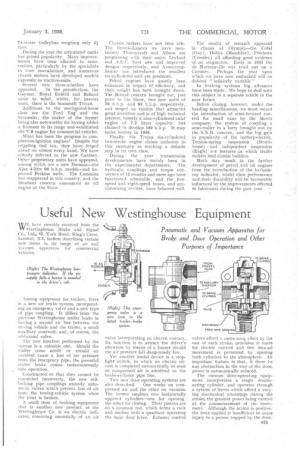Useful New Westinghouse Equipment
Page 31

If you've noticed an error in this article please click here to report it so we can fix it.
Pneumatic and Vacuum Apparatus for Brake and Door Operation and Other Purposes, of Importance
WE have recently received from the W Westinghouse Brake and Signal Co., Ltd, 82, York Road; King's Cross, London, N.1, leaflets describing certain new items in its range of air and vacuum apparatus for commercial 'vehicles.
Among equipment for trailers, there is a new air brake system, incorporating an emergency valve and a new type of pipe coupling. It differs from the previous Westinghouse trailer brake in having a second air line between the towing vehicle and the trailer, a small auxiliary reservoir, and, of course, the add i tional valve.
The new function performed by the system. is a valuable one. Should the trailer come adrift or -should an accident cause a loss of air pressure from the emergency pipe, the powerful trailer brake comes instantaneously into operation.
Constructed so that they cannot he connected incorrectly, the new selflocking pipe couplings embody automatic valves which prevent loss of air from the towing-vehicle system when the joint is broken.
A small item of braking equipment ihat is another new product of the Westinghouse Co. is an electric indicator,consisting essentially of an air
valve incorporating an electric contact. Its function is to attract the driver's attention by means ofa buzzer should the air pressure fall dangerously' low, Yet another useful device is a steplight switch, in which an electric circuit is completed automatically so soon as compressed air is admitted to the brake-cylinder pipe line.
Two new door-operating systems are also described. One works on compressed air and the other on vacuum. The former employs two horizontally opposed cylinders—one for opening, the other for closing. Their pistons are on a common rod, which forms a rack and meshes with a quadrant operating the main door lever. Exhaust control valves afford a cushioning effect at the end of each stroke, provision is made for electric control and free manual movement is permitted by opening both cylinders to the atmosphere. An important feature is that, if there be any obstruction in the way of the door, power is automatically reduced.
The vacuum door-operating equipment incorporates a single doubleacting cylinder, and operates through a system of levers which afford a varying mechanical advantage during the strOke, the greatest power being exerted at the commencement of the movement. Although the action is positive, the force applied is insufficient to cause injury to a person trapped by the door:




















































































